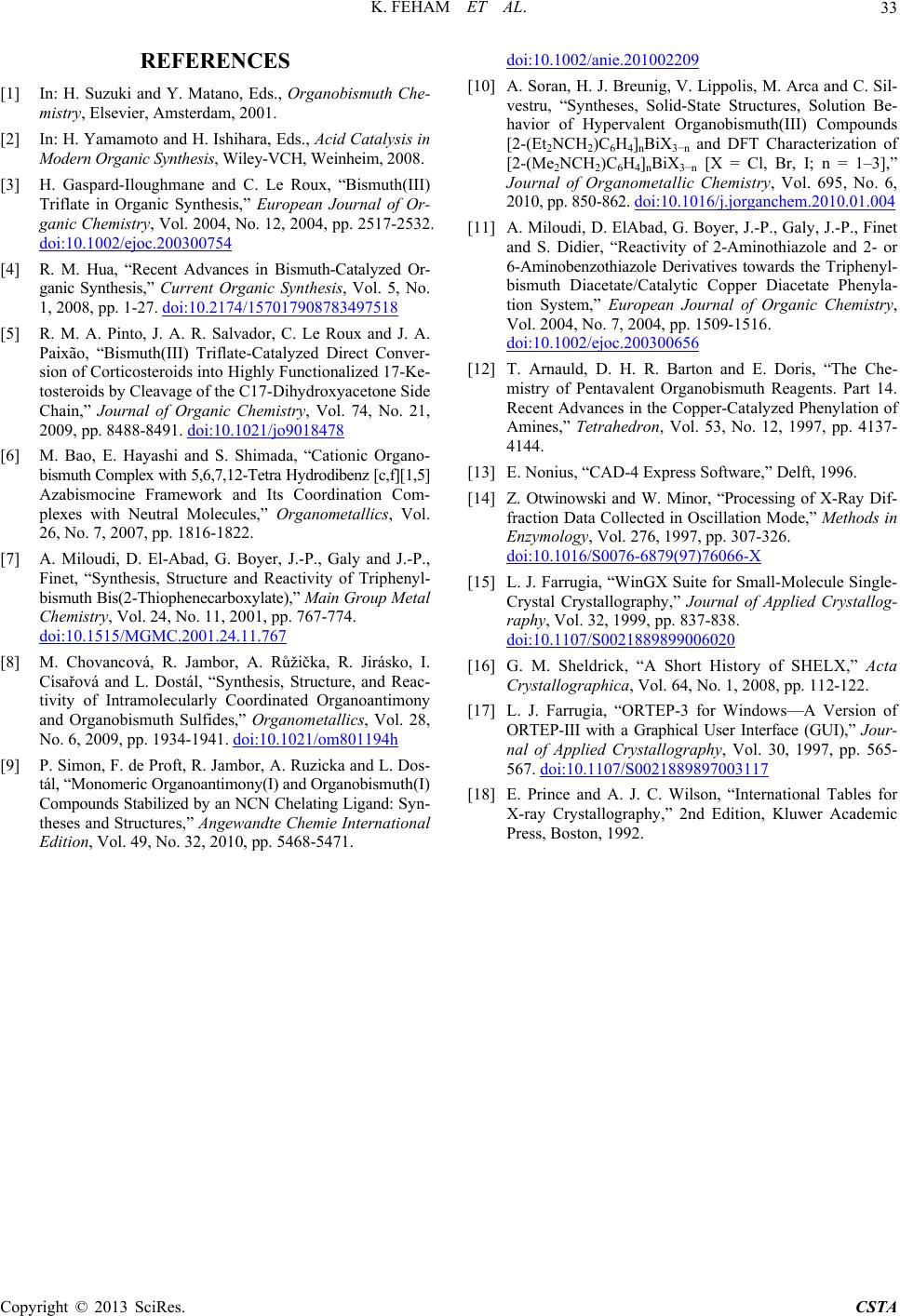
K. FEHAM ET AL.
Copyright © 2013 SciRes. CSTA
33
REFEREN
[1] zuki aatano, anobis he-
rdam, 2
[2] mamot. IshihaAcid Ca
rganic sis, Wileinhe08.
[3] rd-Iloue and C. Le Roux, “Bismuth(III)
Triflate in Organic Synthesis,” European Journal of Or-
CES
In: H. Sund Y. MEds., Orgmuth C
mistry, Elsevier, Amste001.
In: H. Ya
Modern O
o and H
Synthe
ra, Eds.,
ey-VCH, W
talysis
im, 20
in
H. Gaspaghman
ganic Chemistry, Vol. 2004, No. 12, 2004, pp. 2517-2532.
doi:10.1002/ejoc.200300754
[4] R. M. Hua, “Recent Advances in Bismuth-Catalyzed Or-
ganic Synthesis,” Current Organic Synthesis, Vol. 5, No.
1, 2008, pp. 1-27. doi:10.2174/157017908783497518
[5] R. M. A. Pinto, J. A. R. Salvador, C. L
Paixão, “Bismuth(III) Triflate-Catalyzed
e Roux and J. A.
Direct Conver-
sion of Corticosteroids into Highly Functionalized 17-Ke-
tosteroids by Cdroxyacetone Side
leavage of the C17-Dihy
Chain,” Journal of Organic Chemistry, Vol. 74, No. 21,
2009, pp. 8488-8491. doi:10.1021/jo9018478
[6] M. Bao, E. Hayashi and S. Shimada, “Cationic Organo-
nd Reactivity of Triphenyl-
bismuth Complex with 5,6,7,12-Tetra Hydrodibenz [c,f][1,5]
Azabismocine Framework and Its Coordination Com-
plexes with Neutral Molecules,” Organometallics, Vol.
26, No. 7, 2007, pp. 1816-1822.
[7] A. Miloudi, D. El-Abad, G. Boyer, J.-P., Galy and J.-P.,
Finet, “Synthesis, Structure a
bismuth Bis(2-Thiophenecarboxylate),” Main Group Metal
Chemistry, Vol. 24, No. 11, 2001, pp. 767-774.
doi:10.1515/MGMC.2001.24.11.767
[8] M. Chovancová, R. Jambor, A. Růžička, R. Jirásko, I.
Císařová and L. Dostál, “Synthesis, Structure, and Reac-
tivity of Intramolecularly Coordinated Organoantimony
and Organobismuth Sulfides,” Organometallics, Vol. 28,
No. 6, 2009, pp. 1934-1941. doi:10.1021/om801194h
[9] P. Simon, F. de Proft, R. Jambor, A. Ruzicka and L. Dos-
tál, “Monomeric Organoantimony(I) and Organobismuth(I)
Compounds Stabilized by an NCN Chelating Ligand: Syn-
theses and Structures,” Angewandte Chemie International
Edition, Vol. 49, No. 32, 2010, pp. 5468-5471.
doi:10.1002/anie.201002209
[10] A. Soran, H. J. Breunig, V. Lippolis, M. Arca and C. Sil-
vestru, “Syntheses, Solid-State Structures, Solution Be-
0.01.004
havior of Hypervalent Organobismuth(III) Compounds
[2-(Et2NCH2)C6H4]nBiX3−n and DFT Characterization of
[2-(Me2NCH2)C6H4]nBiX3−n [X = Cl, Br, I; n = 1–3],”
Journal of Organometallic Chemistry, Vol. 695, No. 6,
2010, pp. 850-862. doi:10.1016/j.jorganchem.201
yer, J.-P., Galy, J.-P., Finet [11] A. Miloudi, D. ElAbad, G. Bo
and S. Didier, “Reactivity of 2-Aminothiazole and 2- or
6-Aminobenzothiazole Derivatives towards the Triphenyl-
bismuth Diacetate/Catalytic Copper Diacetate Phenyla-
tion System,” European Journal of Organic Chemistry,
Vol. 2004, No. 7, 2004, pp. 1509-1516.
doi:10.1002/ejoc.200300656
[12] T. Arnauld, D. H. R. Barton and E. Doris, “The Che-
mistry of Pentavalent Organobismuth Reagents. Part 14.
Recent Advances in the Copper-Catalyzed Phenylation of
Amines,” Tetrahedron, Vol. 53, No. 12, 1997, pp. 4137-
4144.
[13] E. Nonius, “CAD-4 Express Software,” Delft, 1996.
[14] Z. Otwinowski and W. Minor, “Processing of X-Ray Dif-
fraction Data Collected in Oscillation Mode,” Methods in
Enzymology, Vol. 276, 1997, pp. 307-326.
doi:10.1016/S0076-6879(97)76066-X
[15] L. J. Farrugia, “WinGX Suite for Small-Molecule Single-
Crystal Crystallography,” Journal of Applied Crystallog-
raphy, Vol. 32, 1999, pp. 837-838.
doi:10.1107/S0021889899006020
[16] G. M. Sheldrick, “A Short History of SHELX,” Acta
Crystallographica, Vol. 64, No. 1, 2008, pp. 112-122.
[17] L. J. Farrugia, “ORTEP-3 for Windows—A Version of
ORTEP-III with a Graphical User Interface (GUI),” Jour-
nal of Applied Crystallography, Vol. 30, 1997, pp. 565-
567. doi:10.1107/S0021889897003117
[18] E. Prince and A. J. C. Wilson, “International Tables for
X-ray Crystallography,” 2nd Edition, Kluwer Academic
Press, Boston, 1992.